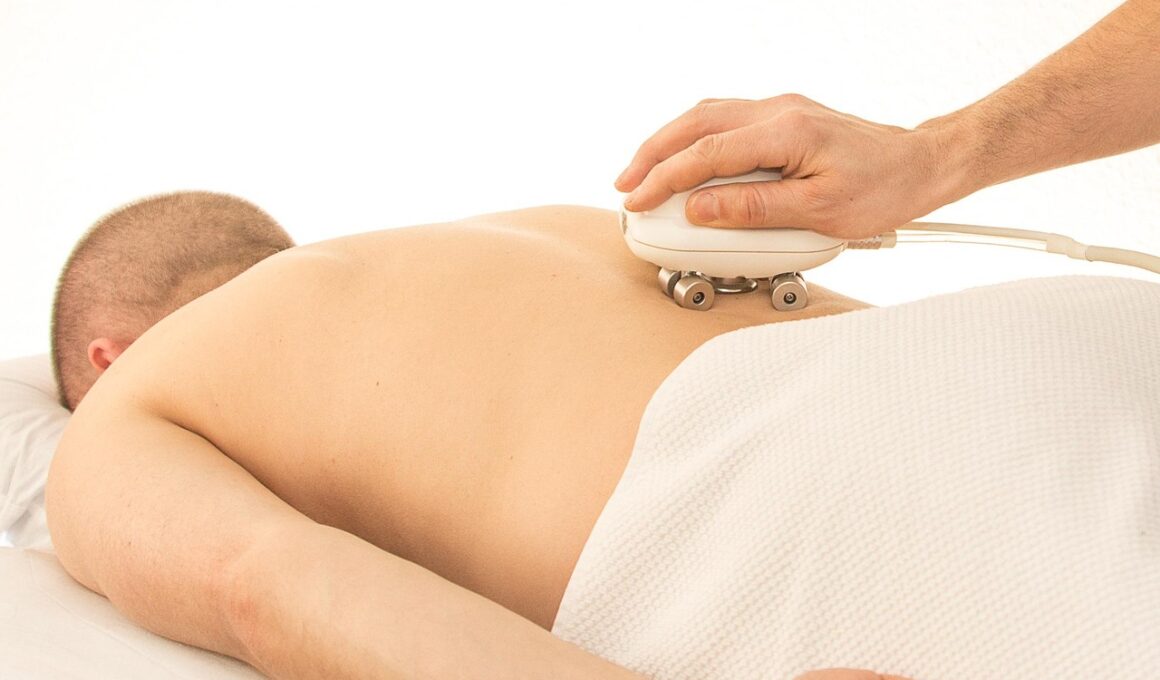Advanced Pilates Techniques for Persistent Back Pain Relief
Pilates is a popular exercise method that focuses on core strength, flexibility, and postural alignment. For those suffering from persistent back pain, advanced Pilates techniques can be especially beneficial. Through tailored routines, individuals can improve mobility, strength, and overall body awareness. These advanced techniques often combine traditional Pilates movements with specialized modifications aimed at relieving pain and enhancing muscle performance. This article highlights some effective Pilates methods designed specifically for back pain relief. By understanding the unique benefits of each technique, patients can make informed decisions when selecting exercises to incorporate into their regimens. Additionally, it is essential to consult with health professionals before starting any new workout, especially individuals with chronic pain. Ensuring that someone follows a guided program under the supervision of a trained instructor will promote safe practice and effective results. Preparing the body adequately for the challenges posed by Pilates movements can prevent injuries and enhance recovery from existing conditions. As we delve into these exercises, we’ll explore specific moves, their benefits, and ways to modify them according to personal ability and pain levels.
One of the most effective advanced Pilates techniques for back pain relief is the use of the Pilates reformer. The reformer provides adjustable resistance and support, facilitating a controlled environment where individuals can engage in challenging movements safely. Exercises on the reformer help to strengthen the core while enhancing spinal alignment. For instance, movements like the reformer footwork target the lower body while promoting proper alignment and engagement of the core. This combination is crucial for individuals with back pain, as it helps distribute weight effectively and reduces strain on the spine. Another key exercise is the ‘spine stretch forward,’ performed on the reformer, which encourages flexibility and a deep stretch for the spine. Adequate flexibility can alleviate tension, making it an essential consideration for anyone suffering from back discomfort. Incorporating methods like the reformer footwork and spine stretch into a regular pilates practice can offer lasting relief. To delve deeper into these techniques, attending classes led by certified instructors is beneficial. They can provide feedback on necessary adjustments for optimal performance and safety, further enhancing the overall effectiveness of your practice.
Targeted Core Exercises
Targeted core exercises are vital in a Pilates routine, particularly for those experiencing back pain. These exercises aim to strengthen not only the superficial core muscles but also the deeper stabilizing muscles crucial for a healthy back. Movements like ‘the hundred’ and ‘leg circles’ focus on engaging the transverse abdominis, a core muscle responsible for supporting the spine. Strengthening these muscles can promote better posture and support structural integrity. Additionally, exercises that promote spinal segmentation such as ‘roll down’ can contribute to increasing awareness of back movements and improving overall flexibility. Incorporating these targeted exercises into a routine allows individuals to gain strength and body awareness progressively. However, it’s crucial to approach these activities gradually, ensuring that each movement is executed with precision. Moreover, those with back pain should monitor their response to each exercise and communicate with their instructor about any discomfort experienced during practice. This feedback loop is essential for modifying movements to guard against injury while enhancing the benefits of Pilates for back pain relief. Combining gradual strengthening with controlled movements can lead to significant improvements over time, fostering a more pain-free life.
Another essential component of Pilates for back pain is focusing on alignment and breathing techniques. Proper alignment ensures that the spine is supported throughout all exercises, reducing stress on the back. Coaches often emphasize maintaining a neutral spine while performing Pilates routines, which promotes better mechanics during each movement. Breath control adds another layer to Pilates practice, allowing practitioners to connect deeper with their bodies while exercising. Emphasizing diaphragmatic breathing during movements maximizes stability and relaxation, which is particularly helpful for those with chronic pain. The relationship between breath and movement enhances body awareness and promotes a sense of calm, helping alleviate stress that may exacerbate back pain. To deepen the benefits of alignment and breath work, setting aside time for mindfulness practices outside of Pilates sessions can be beneficial. Techniques such as meditation or yoga can further enhance one’s ability to manage pain and prevent recurrence. Engaging in mindful practices fosters a holistic approach to health and wellness. When combined with targeted Pilates exercises, the incorporation of both alignment and breathing allows individuals to create a powerful routine addressing persistent back pain with effective strategies for long-term relief.
Mobility and Flexibility Enhancements
Enhancing mobility and flexibility is crucial for managing back pain effectively through Pilates. Limited mobility can lead to muscle tightness, increasing discomfort and pain. Engaging in specific movements aimed at improving flexibility can transform the body’s mechanics dramatically. Advanced Pilates exercises that emphasize rotational, lateral, and extension movements provide a comprehensive approach to enhancement of mobility. Exercises such as ‘cat-cow stretches’ and ‘shoulder bridge’ are essential for promoting spinal flexibility. The shoulder bridge, in particular, actively engages glute muscles, relieving pressure on the lower back. Additionally, many Pilates routines incorporate stretching sequences designed to increase hamstring and quadriceps flexibility, which are critical areas connected to low back pain. Integrating mobility drills and stretches into an advanced Pilates regimen not only alleviates pain but also improves functional movement patterns. It’s beneficial to approach flexibility training progressively, ensuring adequate warm-up before engaging in more challenging exercises. Practitioners should also consider engaging various muscle groups for a holistic approach. Expanding flexibility can lead to a reduced risk of future injuries, ensuring long-term success in managing back pain with Pilates as a central component of their wellness plan.
Incorporating balance exercises into Pilates routines is essential for enhancing muscle stability and preventing future back pain episodes. Many individuals with back pain tend to compensate using incorrect movement patterns, leading to further strain. Including exercises such as ‘single-leg balance’ or ‘teaser’ challenges the body to engage stabilizers actively while promoting postural stability. Additionally, balance practices help to build strength in the core and lower extremities, reducing reliance on the back muscles for support. Focusing on stability enhances not only physical strength but also promotes awareness of body mechanics. As individuals become more proficient in their balance, they may find daily activities become easier and pain levels decrease. Teaching oneself to engage in muscle coordination while enduring balance can lead to fewer injuries in both athletic pursuits and day-to-day tasks. It’s crucial to remain mindful during these exercises, practicing them on stable surfaces before progressing onto more challenging conditions. In this way, Pilates can serve as a fundamental tool in regaining confidence and competence in physical movements. With determination and the right regimen, Pilates practitioners can develop substantially stronger bodies and experience lasting back pain relief.
Conclusion: A Holistic Approach
In conclusion, utilizing advanced Pilates techniques for back pain relief involves a multifaceted approach targeting strength, flexibility, and body awareness. Each technique, when practiced with proper guidance, can lead to significant advancements in physical capability and pain management. Understanding the need for a personalized routine ensures that individuals effectively address their unique challenges associated with back pain. Collaboration with certified instructors allows the creation of a supportive environment where growth can occur without risking injury. Practicing Pilates can lead not only to relief from discomfort but also improvements in overall quality of life. As practitioners become more proficient in their exercises, they will discover the joy of movement, often overshadowed by chronic pain. Thus, engaging with Pilates as a lifelong practice promotes not only physical health but emotional and psychological wellbeing. The journey through Pilates is much more than simply attending classes; it embodies a commitment to self-care and continuous learning. With patience and dedication, those who pursue these techniques have the potential to transform their physical abilities while reducing and managing pain effectively. Embracing this holistic approach enhances the overall success and fulfillment found in Pilates practice.
Ultimately, the journey towards managing back pain through advanced Pilates techniques is a rewarding experience. Establishing a regular practice can yield profound benefits. For beginners and seasoned practitioners alike, the key lies in consistency and mindfulness while engaging in workouts. Choosing the right exercises tailored to personal needs is instrumental in achieving desired outcomes. Each individual must stay attentive to how their body responds during workouts, adjusting movements accordingly. By prioritizing safety and technique, people will foster not only healing but also longevity in their Pilates journey. Committing to continuous education about one’s body mechanics will also enhance the effectiveness of each session. Whether attending classes, utilizing online resources, or collaborating with healthcare professionals, resources abound for those eager to delve deeper. Staying informed fosters confidence in movement and stimulates a proactive approach to overall health and fitness. Somatic awareness developed through Pilates practice strengthens one’s relationship with their body and promotes self-advocacy for injury prevention. Thus, Pilates stands as an empowering method to reclaim control over back pain and enhance overall quality of life. The possibilities are boundless; through dedicated practice, individuals can achieve a liberated and pain-free existence.


